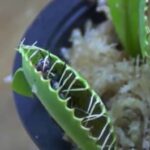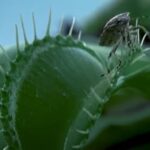As an Amazon Associate, this site earns commissions from qualifying purchases. For more details, click here.
Have you ever noticed some Venus flytraps curl up? This can be somewhat alarming especially for new growers, as those firm leaves suddenly turn inside out. Is this commonplace or could it be a sign something is wrong? Well it depends on various factors.
Venus flytraps may curl to prevent a bug from escaping, so the leaves should straighten after it has finished eating. If the leaves curl up even if it does not eat, it is a sign the plant needs more sunlight.
Why Digestion Causes Venus Flytrap Curling
Venus flytraps catch insects not for food, but for nutrients. Native to North and South Carolina, these plants only grow in poor soil. To compensate for this, Venus flytraps use traps to lure and trap insects. Flies, gnats, caterpillars and other bugs are rich in nitrogen, providing these plants the nutrients they cannot get in the soil.
When a bug lands in one of its traps, a Venus flytrap will do everything it can to prevent its escape. This might result in leaves curling or turning inside out. If this happens, it means the trap is clamping down tightly on its prey.
There are many Venus flytrap cultivars, but all of them must enclose its prey before digesting. Once the trap is airtight, the plant will secrete its digestive fluids and proceed with digestion.
These insects will put up a fight, forcing the trap to squeeze harder. This struggle causes the leaves to curl up. But this is nothing to worry about.
Once the plant has digested its prey, the leaves will return to their normal shape. This might take one to two weeks depending on the size of the meal.
Not all Venus flytraps curl when it catches prey. Small bugs fit in its trap easily, so there is little effort required to keep it there.
Leaf curling occurs if the prey is able to put up a fight. A large moth for instance, will try to fly off or rip the trap. in some cases it will get away but if it is small enough, the trap will ensnare it. However, this will require a lot of effort.
If leaf curling happens, you just need to be patient. Wait a couple of weeks and you will see the trap open up. But what if does not? Well there are other possible reasons.
Lack of Light
If the leaves of your Venus flytrap are curled even without food, it probably needs more sunlight. More light is always good for these plants.
12 hours of indirect sunlight is best for Venus flytraps. Artificial light will work too but make sure it is of good quality. Choose good quality artificial light as it does not harm plants. Place the light at least 7 inches away from the plant and it must not be directly aimed towards it. We recommend Juhefa Grow Lights because they can help these plants grow even with limited natural light.
Healthy Venus flytrap leaves are green, firm and straight. They only curl up to trap prey. If the leaves remain folded, it could be a sign of poor health.
Light is critical for Venus flytraps. Without it they cannot produce glucose, their food. Bugs are nutrients plants use to stimulate growth. These elements help Venus flytraps create bigger traps but they can live without it.
But Venus flytraps cannot live without light. And they need a specific amount, 6 hours minimum and 12 hours ideal.
With minimum sunlight Venus flytraps will survive. But they will be in a weakened state with smaller traps, dull colors and curled leaves.
If your Venus flytrap is indoors and its leaves are curling up, take it outside. Assuming there are at least 8 hours of sunlight (12 is better), its leaves should straighten out.
Once your Venus flytrap leaves normalize, you can keep the plant outside or bring it back indoors. If you decide to move the plant back inside, place the pot on a window porch so it has access to sunlight.
If there is little sunlight available, use artificial light. Remember Venus flytraps need 8-12 hours for the best results, particularly if yours has curled leaves.
Keep in mind that even healthy Venus flytrap leaves might curl when it catches a large insect. But if your plant is healthy, its shape will be restored to normal when the trap reopens.
Weakened Traps
Weak traps are more likely to curl than healthy ones. Traps can be weakened by repeated poking, lack of water, poor soil or lack of nutrients.
Poking the trap to see if it will bite you can weaken or kill it. Venus flytraps can have 5 to 20 traps at a time, but each can only close 3-5 times before dying.
A worn out trap is going to curl up regardless if it has caught something or not. Venus flytraps can produce replacements for these traps if healthy. A Venus flytrap suffering from root rot will have curled, brownish leaves. Worse, a dead, rotting insect might get stuck and rot, producing a foul smell that can spread throughout the plant.
Here are some tips to keep traps healthy.
- Do not poke the trap. Do not touch the trap with your finger. It is not going to bite you and you will just endanger the plant. Do not waste its energy on your finger when it can be used to digest food.
- Do not overfeed. Keep its food intake to 1/3 the size of the trap and it will be fine. If you fill the trap the plant will struggle and could end up inside out.
- Grow the plant in a good environment. Ideally Venus flytraps should have plenty of air, water, light and soil, preferably 1:1 peat moss and perlite. Another excellent option is the Perfect Plant Soil Mix which works with all types of carnivorous plants.
It is easy to speculate on the reasons Venus flytraps curl up. But if you follow the right practices, the traps will be robust.
If you see traps die, it is normal and new ones will take over. As long as you keep your hands off the plant – including pets – you do not have to worry too much about curling.
Using Tap Water
Another possible reason for leaf curling is a polluted water source. Purified water, reverse osmosis and rainwater are the most suitable for these plants.
Tap water might have mineral deposits that are harmful to Venus flytraps. We suggest distilled water as it is free from these elements.
Watering Venus flytraps should not be taken for granted. Tap water will not immediately kill it, but it could have serious long term effects.
Mineral deposits in tap water have a detrimental effect on Venus flytraps. These substances slow down growth and weaken its immune system.
Weak flytraps produce small traps, and they will have a tendency to fold or turn inside out. It may take weeks for the effects to manifest, but by then it may already be too late.
If you want to grow Venus flytraps, purified or distilled water is a must. It makes a huge difference and you do not have to worry if the tap water you use is causing any danger.
Dormant Stage
Another possible and often overlooked reason is dormancy. Venus flytraps that enter dormancy are shriveled and look like they are dying. But this is part of their life cycle and the plant will grow again in the spring.
Dormancy can last up to 6 months. During this time, your Venus flytrap will shrink. It will discard its leaves and some might curl or discolor.
All of these are normal. You do not have to feed it, pour more water or do any of that. In fact that will cause more harm than good.
Do not rush this process as it is required by all Venus flytraps. When the plant blooms during growth season you will see those leaves straighten up again.
Conclusion
Venus flytraps are complex plants, which is why many believe they are difficult to grow. That is not true though. Once you understand how these plants work and why they such things -like curl up- they are easier to manage.

My fascination with carnivorous plants began many, many years ago with Venus Fly Traps. Now I am more than happy to impart what I know with other enthusiasts and those who are curious about meat eating plants.



